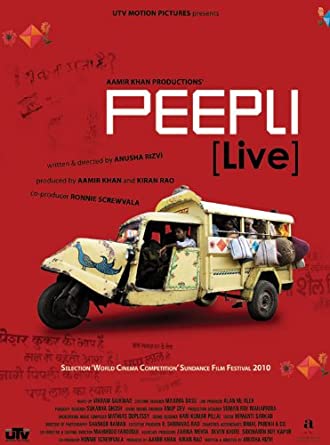In defence of mockery
Published @ The Bengal Post

The much-discussed Peepli (Live) has garnered attention to the logic of employing satire to a case (or a cause) that is hopelessly tragic. The film’s veracity, depicting one of the biggest agrarian crises to have precipitated in Independent India, is unquestionable. The makers have rightly targeted the assorted symbolisms of what we call the ‘establishment’ — the administration, the government, agencies of policymaking and the favourite butt which everybody kicks these days — the 24X7 television media. The critical value of the film is less important than the fact that had the makers had made a dyed-in-the-wool, art-house picture — full of serious intent — the movie, in all likelihood, would have come a cropper. If that speaks certain things about the way we have come to receive and disseminate popular culture over the years (including the decimation of art-house cinema), it also says a word or two about the centrality of farce in cultural discourse, because over the last century or so, farce has come to embody a more terrifying indictment than tragedy.
Cultural critic Theodore Adorno had said that after Auschwitz, there cannot be any art, at least not in the intransient, High Modernist form. Thankfully he was wrong. Because some of the great art of the last century came after and even because of the Holocaust. Though it must be said that even if culture did not self-destruct itself after the decimation of 6 million Jews, it gradually changed the means to the end. The deferential, dark, self-introspective post-Christian ethic of ‘High Modernism’ made way for the forced triviality, pastiche and self-denying mortification of post-modernity. If the loss of the self and the frames defying it was mourned under Modernism, the loss was fêted, with a degree of schadenfreude aimed not at oneself— under its widely contested successor.
No wonder, consensus in cultural critique since the middle years of the last century was that Modernism and particularly post-Modernism had taken away our right to tragedy. Among the cases made in favour of the decline of tragedy the most important perhaps is that in the assorted morbidity of Fascism and Stalinism, humanity has seen and felt to cathartic effect, the worst it could do to itself. And hence tragedy cannot hope to extol any more in life than it can do in art. In other words, blame a more inclusive recognition of Hannah Arendt’s ‘banality of evil’ as to why there are no isolated, tragic moments in the Twentieth century, moments of utmost beauty and deep pathos that once made tragedy possible.
Similarly, comedy has died too, especially the genteel version— a kind that Shakespeare excelled at and Molière chiselled to perfection. It is yet to be decided which of the two deaths made way for farce, but in the times we indeed live in, it is the only genre that perhaps retains some claim to its original prospect.
To cite a recent example, in his new book First as Tragedy Then as Farce the mercurial Leftist philosopher Slavoj Zizek has analysed the global financial meltdown in light of Marx’s famous remark (a remark developed upon a comment by Hegel) that history repeats itself “occurring first as tragedy, the second time as farce” and Zizek, following Herbert Marcuse, note that the repetition as farce can be even more terrifying than the original tragedy. This assertion, even if used in a different context, makes one more case for why it is no more possible to live in the most trying of times — of global warfare, mass murder, terrorism, famine and death — and yet not experience the urge to create a tragic work of art. Because the greatest tragedies of late-modernity, post-modernity and other subliminal profundities of the new Millennium are merely a repetition of the past — of tragic, heartbreaking instances of human evil.
Perhaps a great measure of the force of farce to desiccate the diabolism of totalitarian oppression (and hence unmitigated evil) was found in the string of brilliant satires written in the first few years under Bolshevik rule in the USSR in the now-classic works of Mikhail Bulgakov, (Master and Margherita and Heart of the Dog), Andrei Platonov (The Foundation Pit), Yevgeny Zamyatin (We) and later in Czech authors Bohumil Hrabal (Too Loud a Solitude, Total Fears Letters to Dubenka) and Milan Kundera (Joke, Book of Laughter and Forgetting). Farce is yet to be a chosen form to discuss the Holocaust but even here one of the greatest works (along the more serious ones of Primo Levi and Elie Wiesel) is Maus — Art Spiegelman’s classic comic book memoir. More contemporary examples should be the queer, exhilarating comedies of Emir Kusturica, many of them made in the wake of the Balkan wars; or Italian playwright Dario Fo’s extended commedia dell’arte critiques of organised, exploitative capitalist orders.
Peepli (Live) rightly finds satire in the near-total decay of the Indian farming class and the near-total decimation of mass media. The case of Peepli (Live) is even fresher, given Hindi cinema’s lack of association with the more calibrated genres of high art, particularly satire, the last great case being the iconic Jaane Bhi Do Yaaro. A well-rendered, considered farce like Peepli (Live) and its positive reception show that as a spectator commune, we are gradually getting to a place where we can laugh at our most miserable lots. If Zizek is to be believed, twenty years ago, this would have been a tragedy. Now it’s doubtlessly a farce. Cheers to that!
comments for this post are closed